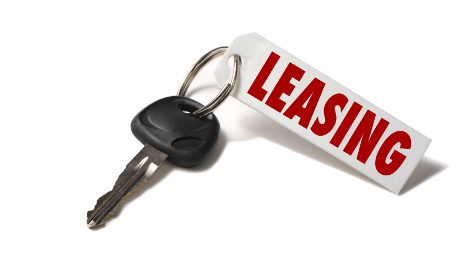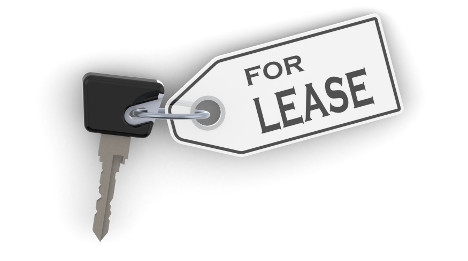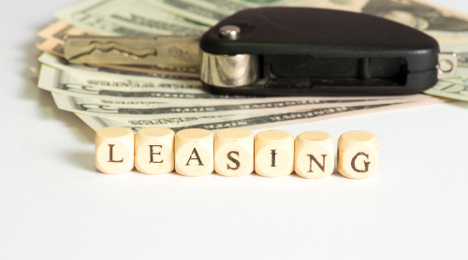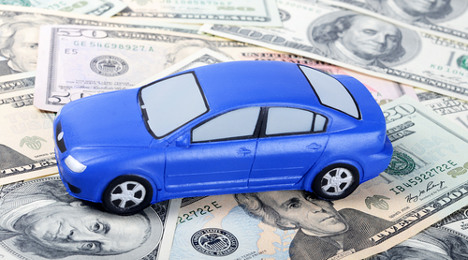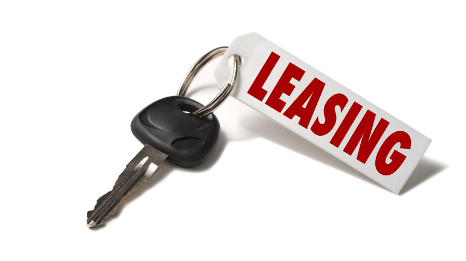Lease penetration is down for the first time since 2012, and the decline in leases written is twice as high as the drop in overall new-car sales, according to latest Lease Market Report from Edmunds.
That said, leasing remains close to record highs, and the swell of off-lease volumes hitting the used-car market should continue for some time.
Lease penetration in the first half of the year was at 31.1 percent. A year ago, it was a record 31.9 percent, Edmunds said.
According to a chart in the report, the last time there was a decline in lease penetration during the first half of the year was 2012, when it dipped from 22.6 percent to 21.4 percent.
Rates then climbed for four straight years.
There were 2.1 million vehicle leases in the first six months of 2017, down 4.4 percent year-over-year. That dip is twice as high as the overall decline in new-car sales, which was at 2.2 percent, Edmunds said.
“Leasing remains a popular choice among car shoppers, but the era of steady growth is over,” Edmunds executive director of industry analysis Jessica Caldwell said in a news release.
“This year we’re seeing a drop-off in trade-ins going toward leases, signaling that the pool of people opting to lease is shrinking,” she said. “Automakers are becoming more reliant on buyers already in the leasing cycle and first-time car buyers.”
However, Edmunds is still expecting 4.3 million leases this year, which would be the second-highest total (next to last year’s 4.5 million leases) in the report’s 11-year data set.
“We may be hitting a ceiling on leasing, but automakers will continue to keep feeding the machine because it’s a selling tool that’s too valuable to neglect,” Caldwell said. “Leasing remains an incredibly popular way for consumers to afford the cars they want, so automakers are digging deeper to offer the eye-catching payments consumers have come to expect.”
And counting 2017, annual lease volumes have been above 3 million for five straight years. Though the total volume is likely to dip this year, there has been an increase in annual lease volumes every year since 2009, according to Edmunds.
Based on the numbers the company provides, there were 14.3 million vehicles leased between 2014 and the first half of this year.
That certainly has had and will likely continue to have a dramatic impact on the amount of late-model used-car supply reaching the market.
Cox Automotive predicts there will be 3.6 million lease returns this year, with 4.6 million set for 2020.
A year ago, there were 3.0 million.
And all of this can impact prices on those late-model used cars.
The value of a 3-year-old vehicle in the first half of 2017 was down an average of 35.6 percent from its original value, Edmunds said. In 2014, depreciation was just 31.8 percent for 3-year-old cars.
“This increase in depreciation indicates leasing is becoming a more expensive endeavor for automakers. In order to offer consumers low monthly lease payments, automakers must increase their incentive spend to offset the drop-off in used values,” the Edmunds report said.
Average lease incentives were at $4,400 in the first half of the year, compared to $3,700 in the same period of 2016. This year’s figure is also the highest in Edmunds' 8-year data set of first-half lease incentive spending.
Ironically, Edmunds said the increased incentives don’t necessarily result in a better deal for the lessee: “Instead, the outlay is merely mitigating the predicted decline of a vehicle’s future value.”
As lease offers abound, monthly payments on 39 vehicles maintained their current price points, according to analysis shared by Wantalease.com on Tuesday.
Site officials added there are 15 models being offered for $200 per month or less and three vehicles currently available for lease at less than $150 per month.
Those units with the least expense monthly lease payment include the Nissan Sentra SV, Volkswagen Jetta S and Nissan Altima 2.5 S, Wantalease.com found. The Nissan Sentra SV and the Volkswagen Jetta S are both currently priced at $109 per month, making them the most affordable vehicles for the month.
Site officials pointed out the Nissan Sentra SV has remained at the same price for three months but the Volkswagen Jetta S decreased in price by 29.4 percent since last month.
Only one luxury vehicle is currently offered at less than $350 monthly: The Infiniti Q50 2.0T Premium for $329 per month. With its price tag stable, site officials added that this vehicle has not fluctuated in price for the past three months.
“Good deals on popular leased cars are remaining steady as summer continues,” said Scot Hall, executive vice president of Wantalease.com. “As dealers continue to try to find ways to attract more lease shoppers, we expect these prices to remain stable in the coming months.”
The Ford Fusion SE FWD also saw significant price declines from the previous month. The Ford Fusion SE FWD dropped 16.7 percent with a monthly payment of just $169 per month.
On the other hand, the Chevrolet Silverado 1500 4WD saw the largest increase in price from June to July, with its monthly lease offer rising 33.33 percent. The model is currently offered at $339 monthly.
The newest report from AlixPartners — whose client roster includes corporate boards and management, law firms, investment banks and other kinds of investors — cautioned the industry that a “used-car time bomb” is about to explode.
AlixPartners explained that it arrived at that dire assertion through a project that began two years ago through what the firm identified as the “CASE” trends that are “completely revolutionizing” the automotive industry — the connected, autonomous, shared and electric vehicles of the not-too-distant future.
AlixPartners released this analysis detailing how automakers, suppliers and other industry players need to evolve their organizations and their partnering approaches to successfully transition to a “new automotive ecosystem.”
Using several examples, the firm detailed where companies, often relying on traditional auto-industry approaches, are falling behind and why they should consider revamping their operating models.
The report projected a significant downturn in U.S. new-vehicle sales ahead, to 16.9 million light-vehicle units this year and to a cyclical trough of 15.2 million units in 2019 — partly driven by a “used-car time bomb” of 500,000 more off-lease vehicle-returns in 2017 versus 2016, on top of the 500,000 more units in 2016 versus 2015.
The reports noted these trends will likely be a “double-whammy” to new-vehicle sales, displacing turns to cheaper used vehicles while increasing lease payments on new vehicles as leases get written with anticipated higher residual rates and tighter credit standards.
While dealerships might be turn more used vehicles, AlixPartners also mentioned that as more off-lease vehicles fill the wholesale market, firm analysts are projecting that used-vehicle prices will soften at a rate double the 13-percent drop they believe already has happened since 2014, costing captive finance companies up to $5 billion.
Beyond just the growth in off-lease volume, AlixPartners spent much effort on looking at how vehicle technology is going to impact which models might roll over the curb more quickly and which ones might need a spiff to get delivered.
On the connectivity front, the AlixPartners analysis pointed to the example of Tesla’s “high-spec” center-stack display, featuring over-the-air upgrades from the company and iPad-like features. Though this feature has been on the market since the 2012 model year, and has garnered strong reviews from consumers, AlixPartners noted that no other major automaker has moved to match the system.
On the autonomous-vehicle front, the AlixPartners analysis found there are now more than 50 major companies now working on autonomous vehicles or full autonomous-vehicle systems, as well as a plethora of smaller companies and start-ups. This “Wild-West” environment will likely result in a handful of big winners, according to the study, but on the other hand, also many disappointed investors.
The report also mentioned that many of the newer high-tech entrants have completely different “DNAs” than traditional automotive companies, including being used to high returns on capital. Given the “white-hot” competition brewing, the analysis predicts that AV systems-costs could drop 78 percent by 2025.
On the shared-mobility front, the analysis included a survey of a total of 2,000 U.S. adult consumers that showed just how fast things are changing in today’s automotive world.
The survey polled 1,000 consumers across 10 large markets where both car-sharing and ride-sharing are popular (the metro areas of Austin, Texas, Boston, Chicago, Los Angeles, Miami, New York, Portland, Ore., Seattle, San Francisco, Oakland, Calif., and Washington, D.C.) and, as a control group, 1,000 respondents across the entire U.S. This effort mirrored a consumer survey by AlixPartners in November 2013.
In this year’s survey, consumers in the 10 trend-setting markets said their awareness for virtually all major car-sharing brands (names such as Zipcar, Car2Go and Enterprise CarShare) has decreased, and 21 percent of respondents were unable to name any brands at all.
By contrast, this year’s survey also asked users of ride-sharing (brands like Uber and Lyft) in those same 10 markets about their intended usage in the next 12 months versus their past usage, and 24 percent said their usage would be more than in the past, versus just 5 percent who said less — an 18-percentage-point difference.
Meanwhile, AlixPartners said just 17 percent of car-sharing users surveyed in those markets said they would employ car-sharing more in the coming 12 months than in the past — versus 16 percent who said they would use that mobility service less in the year ahead.
Moreover, among respondents in the 10 markets, the survey found that ride-sharing was five times more likely to be a top-three transportation mode than was car-sharing (11.6 percent versus 2.5 percent), and three times more likely than traditional taxis (11.6 percent versus 4.2 percent).
In addition, among millennials surveyed in the key markets, 9 percent said ride-sharing has allowed them to postpone or avoid getting a driver’s license — what AlixPartners contends is another indicator of today’s fast-changing times.
Another key finding of the survey, coupled with AlixPartners analysis, is that in the 10 key markets each vehicle used in car-sharing is likely replacing the need for 19 personal vehicles — a decrease from 32 vehicles based on the results from AlixPartners’ 2013 survey.
Meanwhile, according to the same analysis, one vehicle used in ride-sharing is likely displacing four personal vehicles. The report went on to note that both ride- and car-sharing vehicles are typically replacing vehicles driven less than 5,000 miles per year, not typical commuting vehicles.
On the electrification front, the AlixPartners study reveals that China is investing heavily to take a leadership role in electric vehicles. In an example of that, the report noted that Chinese automakers commanded 96 percent of the 2016 market in China for full electric vehicles (not including hybrids), more than double their share (43 percent) for all types of light vehicles. It also finds that of the 103 EVs to be launched globally by 2020, 49 of them will come from China-based automakers.
The report additionally predicts that China is targeting to have two-thirds of the world’s manufacturing capacity for lithium-ion batteries by 2021 (175 GWh of power, or the equivalent of five Tesla “giga-factories”).
Meanwhile, the report recapped that hybrid sales in the U.S. have slowed, from 3.2 percent of the market in 2013 to just 2.1 percent so far in 2017, while plug-in and battery-electrics sales, while increasing, still represent only 1.0 percent of the market. This, says the study, underscores the need for maximum flexibility in both organizations and partnerships to handle the expected, but bumpy, shift to the new automotive ecosystem that’s coming.
Finally, and also in a way on the partnership front, the AlixPartners study determined that private-equity firms have switched, in droves, from being buyers to sellers — most often to “strategics” (companies in the auto industry already), as private-equity-to-strategics deals skyrocketed from 6 percent of total auto-M&A transaction values in 2013 to 84 percent in 2016.
John Hoffecker, global vice chairman at AlixPartners and a 30-year automotive veteran, said, “There’s an all-new automotive ecosystem developing, and I fear that many players really aren’t prepared for it. The changes coming are the biggest since the internal-combustion engine pushed aside horses and buggies, yet what the exact changes will be are as unpredictable as trying to guess which app is going to be most popular on next year’s smartphones.
“Leading players will be those that both study hard and are fast on their feet,” Hoffecker continued.
Mark Wakefield, global co-head of the automotive and industrial practice at AlixPartners, added, ”With the rapid but uncertain developments in connectivity, autonomy, shared mobility and electrification, traditional approaches to partnering and running organizations could well be setting up the auto industry to be disrupted.
“Fast and savvy organizations that build their own agile ecosystems and create smart partnerships, but without locking themselves into technologies that may become quickly outdated, will be best positioned to afford the needed ‘CASE’ investments of the future and to prosper from the coming industry changes rather than being rolled over by them,” Wakefield went on to say.
Your credit is good and the lease contract on your 2015 vehicle is about to expire: what are your options? You could choose to pay the residual and keep your current ride. You could trade the vehicle for a new one or for an alternative used car. Finally, you could hand in the keys and wait for the bus to take you back home.
When thinking about the effect of the ongoing surge in off-lease volume, it is important to keep these options firmly at the front of mind. Market participants are right to fret about the possible effects of off-lease volume, but not for the reasons usually put forward. Returning an off-lease vehicle certainly causes an increase in supply but, usually, it also generates demand for a replacement vehicle.
Determining the manner in which these forces balance is not a straightforward exercise. One could argue that if the customer leaves with a higher valued vehicle, there has been a net increase in demand because of the transaction. Yesterday the customer was happy driving a $10,000 car. Today they are driving a $20,000 car, therefore they have demanded “more” car. If the client leaves on foot, or in a lower valued vehicle, the net result is an increasing supply to the market. Most commentators, when considering the ongoing surge in off-lease volume, ignore this complexity, recognizing the car entering the lot but ignoring the one that leaves.
The other point is that the distinction between the new and used markets for cars, at least on the demand side, is a fine one indeed. The last time I bought a car, I entered the dealership determined to buy a used Jeep Wrangler. That I drove away in a brand new one suggests either that relative prices were favorable or the sales person was very good at their job. If a sucker, like myself, is enticed to switch to a new car, the used car market does not really suffer. There exists only a market for cars, and players in this space would, frankly, rather sell you an expensive new one than a cheaper old one. If someone swaps their used off-lease vehicle for a new one, this transaction is a positive outcome for all players in the auto industry.
In reality, only three factors unambiguously affect the overall supply of cars in the economy and hence the prices we expect for cars for a given level of demand. The factors are domestic new production, net imports of new and used vehicles, and the rate at which older vehicles are retired from service.
The first two of these factors are easy to quantify using readily available statistics. Compiling data from various trade sources, we find that real net vehicle imports grew by 20.4 percent in 2015 before slowing to 5.8 percent in 2016. Domestic production, meanwhile, continued its slow secular decline that began immediately after the recovery from the Great Recession. The number of cars manufactured in the U.S. fell by 2.1 percent in 2015 and by 5.9 percent last year. These figures should be viewed in the context of consecutive record new vehicle sales numbers over the past two years. If we assume that imports and home-grown cars are roughly equally prevalent, we find that there was a surge in vehicle supply in 2015. This surge was driven primarily by a climbing greenback, but 2016 was basically a wash.
New vehicle manufacturers from around the world might be tempted by the surge in off-lease volume to increase production relative to baseline. People returning three year old leased cars, after all, have recently demonstrated a willingness and an ability to drive a new car away from a dealership. Carmakers know that these people are prime prospects because they need wheels the moment the keys are returned. If this sales strategy is unsuccessful, which happens if non-traditional lessees return to used car ownership, we might be left with a glut of cars in the marketplace that are too new for the prevailing market.
At the other end of the spectrum, a consideration of old car retirement is also needed. We recently conducted a deep-dive on the nature of U.S. passenger vehicles by considering the most recent Consumer Expenditure Survey, conducted in 2015. Respondents were asked about the vehicles they owned and model years were recorded. We can use these data to determine, with some precision, the age profile of the U.S. vehicle fleet.
In 2008, on the eve of the Great Recession, 42 percent of vehicles owned by Americans were ten or more years old. By 2015, in contrast, a full 52 percent of vehicles had been around for a decade or more. The aging fleet is partly due to ongoing improvements in production standards. The numbers also suggest, though, that there are lots of clapped out cars on the road that are due to be retired. By our calculations, the number of vehicles entering retirement each year grows by 25 percent between 2013 and the high-water mark that arrives in 2019. This high rate of vehicle retirement represents a reduction in supply that helps to cushion any increase in production at the new end of the pipeline.
The other startling feature is the dearth of autos in the 5- to 9-year-old range — vehicles that were introduced to the market during the depths of the recession. In 2008, 34.6 percent of cars fell in this band but had fallen to only 24.6 percent by 2015. If lessors are currently feeling the heat, it is nothing compared to the inferno they will face if they are currently originating large volumes of three-year leases. The rate of vehicle retirements plummets in 2020 as the thin cohorts hit peak retirement age. This inevitable process yanks away the cushion from the vehicle supply chain.
To summarize, we currently have lots of new cars, lots of old cars, and very few middle aged cars in the national fleet. This situation leads to some interesting dynamics in the pricing of automobiles. For one thing, the prevalence of lightly used cars means that new vehicle manufacturers have very little pricing power. We have seen new vehicle sales fall markedly this year, and generous incentives have been offered to move stock.
We have also seen significant compression in used car prices. This can be seen, for example, in the average of all wholesale transactions for 0-3 year old vehicles from the NADA Auction.net database. Our analysis shows that prices of light trucks have fallen by 3 percent since their peak value in 2011, while car prices have declined by a full 13 percent. In contrast, 4- to 6-year old cars have fallen by only 4 percent while older trucks have surged higher by 10 percent. In other words, relative discounts one might expect when purchasing an older vehicle have declined considerably. People who are in the market for a 5-year old car are finding that they can get a 3-year old version without spending much more money.
So, where does all this analysis leave us? It is the combination of too much production and insufficient demand for new vehicles that is depressing newer car prices. It is not that there are too many cars in the market alone. Production (which includes imports) has shown signs of slowing, suggesting that manufacturers have worked to curtail the emergent glut of new cars.
Financial interests are far more exposed to prices of new and slightly used cars than they are to prices of older cars and clunkers. Markets are therefore watching the auto industry closely for signs of strain.
When thinking about car prices, close attention should be paid to the nature of vehicles being driven; the manner of their financing is rather less consequential.
Tony Hughes is a managing director at Moody’s Analytics, where he leads the development of used-car price forecasts. Hughes also conducted a webinar about this topic with Auto Remarketing earlier this year that’s available here.
In lieu of the traditional test drive, a number of shoppers are most interested getting the best deal possible, says eAutoLease chief executive officer and founder Zoriy Birenboym.
“You can do pretty much everything without leaving the comfort of your home or office or school, or where ever you maybe. Once you choose and you decide with one of our associates or reps you fill out an application online right on our website which is secure,” Birenboym said when explaining his site to Auto Remarketing.
On the site, consumers can research look hundreds of different offers, speak with a live representative and request a quote, according to Birenboym.
As protection, the site is fitted with trust guard and widgets for security, he said.
When a customer is approved for the vehicle of their choice, they are given a VIN number and asked to provide proof of insurance. Following that, they can arrange their vehicle’s delivery to their home or office.
“We make your entire experience hassle-free, headache-free, without having to wait for hours seated and waiting for the manager and the finance manager — we cut all of that out,” he said.
Birenboym continued, “A customer might call and ask ‘what do you guys recommend?’ or ‘this is my budget’ or ‘I like a smooth ride.’ We tell them this fits your budget, this fits your comfort, this fits your driving pattern. It depends on what the consumer wants. We do what we can to fit the customer every way possible.”
The company also helps shoppers figure out if they are eligible for rebates and incentives.
Birenboym said some customers are unaware that they’re eligible for discounts from their employers or that there are special offering out there for shoppers who are vets and college grads.
Inside Getalease.com
Another company working in the leasing arena is Getalease.com, whose chief executive spoke recently with Auto Remarketing about used-car leasing, in particular.
“I’ve always been into used leasing and thinking that used leasing will help mitigate the oversaturation. So, what I ended up doing was, I created a lease calculator that enables used-car leasing,” Getalease.com chief executive officer Zak Sabbagh told Auto Remarketing during a phone interview.
Getalease.com’s used-car calculator allows shoppers to choose different payment selections. As each option is clicked, the calculator adjusts to accommodate the residual and the money factor.
“It’s pretty easy and hands on. I try to make it as easy as possible,” Sabbagh said.
An added value is that the used-car calculator is not just a consumer-facing tool to educate the customer, it also educates the dealer, according to Sabbagh.
He said online leasing hasn’t succeeded in the past because it takes too long for a dealer to sit there and run calculations.
“They’re never going to do that, they’re never going to waste hours in a day to run hundreds of calculations,” he added.
“In used-car leasing, not every vehicle is a home run, not every car is going to be $13. There are plenty of instances in used-car leasing where the used-car can lease out for the same price or even more money than the new car.”
Sabbagh said the main idea behind developing the calculator was to create a tool for VIN-specific-based calculations.
“I’ve always been under the impression that used leasing, in general, can ultimately help save or at least help mitigate some of the risk that OEMs are taking with their saturation,” Sabbagh said.
He said used-car leasing is much more complicated than new because it requires dealers to perform a number of more calculations.
“It's more tedious, there is more to it. There are different residuals that you have to apply upwards and downwards to get the unique payments for each vehicle,” he explained.
“We took that entire process and automated it and then not only did we automate it but we created a way for the dealer to look at the rate and the residual specifically for that VIN number, ultimately calculating their entire inventory automatically.”
CORRECTION: An earlier version of this story said eAutoLease offers used-car leasing. It is only involved in new-car leasing and the story has been updated as such. Additionally, certain quotes from Getalease.com chief executive officer Zak Sabbagh have been corrected.
Wantalease.com highlighted on Thursday that there currently are 15 vehicles offered for a monthly payment of $199 or less; and three models where the monthly commitment is below $150.
Boasting the lowest monthly payment on the site is the Nissan Sentra SV, which site officials pegged the obligation at $109 per month.
The site calculated that the average monthly payment of today’s most popular vehicles to lease is currently sitting at $340.37, down slightly from last month’s average of $352.80. Wantalease.com tracks monthly payments currently on the road across 60 of today’s most popular makes and models.
Three small SUVs are currently offered at $199 per month: the Chevrolet Equinox 2WD LS, the Honda CR-V LX 2WD and the Nissan Rogue S FWD. The Acura ILX is currently the lowest-priced luxury vehicle at $219 per month.
The Chevrolet Silverado LT Crew Cab saw the largest single-month drop in payment, falling by 16.8 percent from May as the model is now offered at $289 per month. The Chevrolet Equinox 2WD LS also dropped by 15.3 percent in monthly payment, as one of the three trucks offered at $199 per month.
Other luxury models offered at deals currently include the Audi A3 2.0T FWD Premium ($299 per month) and the Lexus IS 200t (Turbo) at $319 per month.
“With monthly vehicle sales struggling a bit to maintain momentum of the last few years, we’re seeing a continuation of aggressive lease pricing on many of today’s more popular cars and trucks,” said Scot Hall, executive vice president of Wantalease.com.
“Yesterday’s lease deals were largely confined to luxury makes and models, but today we’re seeing low prices on a wider variety of cars and trucks, including utility vehicles,” Hall went on to say.
Wantalease.com is a sister marketplace to Swapalease.com, one of the nation’s largest online marketplaces for leases.
It appears consumers’ desire for a luxury model and their financial capacity to take over a lease didn’t mesh together well last month.
Swapalease.com reported on Tuesday that vehicle lease credit applicants registered just a 48.1 percent approval rate during May, the lowest approval rate tracked by the company dating back to 2014, when the monthly approval ratings began.
Company officials pointed to a higher-than-normal influx of applicants looking to take over higher-end luxury leases, especially high-priced SUVs that come with payments ranging from $600 to $700 each month. Swapalease.com noted that applicants for leases in this price range usually result in higher declines from applicants failing to meet the credit requirements of the lease company.
Year-to-date, the vehicle lease credit approval rate has registered a monthly average of 61.1 percent, which compares to 67.7 percent for the same period last year. Over the last three months, the lease credit approval rate has averaged 62.1 percent.
“We’ve been tracking a rise in the number of people searching and attempting lease takeovers on higher-priced luxury SUVs recently,” said Scot Hall, executive vice president of Swapalease.com.
“With a healthy economy and moderate fuel prices, we believe people are feeling confident in obtaining a higher monthly vehicle payment each month,” Hall continued. “Unfortunately, their attempts aren’t always successful, especially if their credit just doesn’t match the appetite for their desired vehicle.”
Used-car buyers are shelling out close to 4-percent more money on their down payment than they were a year ago, according to data released Friday by Edmunds.
And their down payments — which averaged $2,529 in May — are more than 12 percent higher than five years ago.
Those numbers are even more pronounced on the new-car side, Edmunds said.
All this amid a new-car market where incentives, leasing and interest rates are on the rise, and a used-car market where steadily climbing off-lease supply is putting a bit of pressure on prices.
Down payments, monthly payments on rise
According to Edmunds, the average down payment for a new car was $3,801 last month, which is 6.5 percent higher than May 2012 and 15.3 percent higher than five years ago.
The average amount financed on a new-car purchase last month was up 1 percent at $30,314, which amounts to a 5-year change of 15.9 percent.
Monthly payments on new cars ($510) were up slightly year-over-year (1.2 percent), but have climbed 10.6 percent in five years, Edmunds said.
For used cars, monthly payments fell 0.2 percent from May 2016 (coming in at $385) but have jumped 4.1 percent in five years. Pre-owned car buyers are financing $21,310 on average, Edmunds said, which is down 0.9 percent from a year ago but up 11.3 percent from 2012.
“Buyers want pricier cars with more bells and whistles, leading to the troubling trend of trading longer loan terms for lower monthly payments,” Edmunds executive director of industry analysis Jessica Caldwell said in a news release.
“But now that interest rates are also on the rise, something has to give,” she said.
In fact, the average APR on a new car in May (5.0 percent) was a 12.7-percent hike from May 2016 and a 14.9-percent uptick from 2012. The used-car APR (7.63 percent) was up 4.5 percent year-over-year, but down 7.8 percent from five years ago.
“In our increasing credit-based culture where consumers are willing to finance everything from cellphones to vacations, more money up front shows car buyers aren’t completely sacrificing practicality in order to get the cars they really want,” Caldwell said.
And they may be getting some help from automakers.
Incentives of all stripes see increase
In a separate commentary provided to the media, Caldwell said there was a 33-percent year-over-year spike in finance incentives last month.
Lease incentives jumped 28 percent and cash incentives were up 18 percent, she said.
"While demand for new vehicles is still relatively strong, it's a bit of smoke and mirrors. Dealers and OEMs really pushed the deals over the holiday weekend to prop up their May numbers,” Caldwell said. “Incentives were up sharply, and it seems automakers are putting more cash on the hood to nudge car shoppers to buy versus lease.”
Leasing still elevated, creating some risk
That said, leasing rates have stayed high.
In a conference call with the media on Thursday, Kelley Blue Book senior analyst Alec Gutierrez said that lease penetration of retail new-car sales in May (excluding fleet and rental) was a shade under 30 percent.
“Leasing still remains a popular option for many, but that will become more and more costly for manufacturers to support certainly in the second half of 2017 to some degree, but as we get into 2018 and 2019, it’s only going to grow to be more and more challenging,” he said. “And that’s specifically because there’s been a steady yet not insignificant rise in off-lease volume returning to wholesale auctions across the country.”
Year-to-date, late-model used-car prices have declined somewhere “in the 3-percent range,” Gutierrez said. Residual values, which provide a base for what the wholesale market may look like a few years in the future, have demonstrated a “similar” downturn, he said.
“So with residual values taking a hit (and) some potential interest rate increases maybe later this year or in the years to come, leasing will grow to be a bit more costly for manufacturers,” Gutierrez said, “which would only put more downward pressure on the new-car market considering that, again, that represents 30 percent of all retail sales.
“And even for those that don’t choose to lease, you are seeing more and more folks take longer-term loans,” he said, adding that 72- to 84-month loans had greater share recently.
In May, the average new-car loan term was 69.1 months, according to Edmunds. That’s up 1.1 percent year-over-year, but up 6.6 percent from five years ago.
For used cars, the average loan term of 67 months was slightly less than a year ago (down 0.2 percent) but up 6.2 percent from 2012.
Targeted incentives?
Brad Korner, who is the general manager for AIS Rebates, said in commentary provided by parent company Cox Automotive that automakers are targeting aged inventory and slower markets with their incentives.
This gives them more control over spending, while getting those older cars off the lots and insulating some of the vehicles with bigger profitability, he said.
“Automakers are showing more consistency, with many national incentives scheduled to remain in place for the next 30 days,” Korner said in the comments released Thursday. “Several OEM’s announced in early May that their incentives would remain the same through June, leaving them flexibility to layer regional incentives on specific models or where they can win market share.”
The wave of off-lease vehicles volume is at its “high tide,” according to Scotiabank, which says lease return numbers — and their subsequent impact to used-car prices — should begin to calm down.
The peak in leasing growth was in 2013-14, the company said in its latest Global Auto Report. Lease penetration rates grew at an average of 2.5 percentage points per year in those two years, climbing from 22 percent to 27 percent.
The growth rate during those two years was twice as much as the average annual growth rate during the 15 years prior, Scotiabank said. Put in hard numerical terms, that 5-percentage-point growth over two years equaled close to 1.5 million units being added to the leasing pool, according to its report.
With those cars now coming out of those leases and hitting the remarketing segment in droves — off-lease volume is up 30 percent year-over-year, according to the report — it has spawned the current “price scare,” the company said.
Among the factors Scotiabank suggests is pushing the used-car price handwringing have been: 1) news of the country’s largest car renter seeing lower residual values drive its quarterly losses further than anticipated, and 2) rising lease returns.
But that aforementioned lease return growth and its price impact won’t last long.
“We believe that the industry is currently in the ‘eye of a used-car price storm,’ and that pricing will stabilize later this year once the growth in off-lease vehicles moderates,” Scotiabank senior economist and auto industry specialist Carlos Gomes said in a news release.
“Our expectation is that weakness in retail activity will prove to be temporary, as it likely reflects a shift among many consumers into used vehicles, due to improving affordability,” Gomes said.
That’s not to say leasing stopped growing. It didn’t.
But the growth in the number of cars leased became less rapid. Last year, the growth was less than 400,000 units, compared to the aforementioned growth of 1.5 million units (combined) over the course of 2013 and 2014, according to Scotiabank.
At the moment, the market is still in the thick of the off-lease wave.
And some would argue that it’s not done.
“The leasing surge we’ve seen over the past few years is taking hold and changing the face of the used-car market,” Edmunds senior analyst Ivan Drury said in a news release accompanying the firm’s latest Used Vehicle Market Report. “With new-vehicle sales already beginning to stagnate, swollen inventories of off-lease used vehicles hitting the market and priced to move may cannibalize new-car sales and further strain residual values.”
The first quarter retained value on 3-year-old vehicles has slipped each year since 2012, according to Edmunds. In the most recent period, it was at 64.5 percent, down from 65.6 percent in Q1 2016 and 68.5 percent in Q1 2012.
The report says that residuals are being pressured by off-lease volumes that flooded the market.
“Lease returns will continue to flood the market over the coming years, while older used vehicles are poised for higher prices due to the supply shortage,” said Drury.
In the report, Edmunds also suggests that “leasing’s supply of near-new is forecast to last nearly three more years.”
A chart in the Edmunds report shows that lease penetration (31.7 percent) and lease volume (1.02 million units) in the first quarter of this year, while high, were down slightly from year-ago levels. That said, the report notes: “While older used vehicles are poised for higher prices due to the supply shortage, lease returns will continue to hit the used market at elevated levels for the next two years, further reducing the values of near-new vehicles as we saw at the start of 2017.”
In a press conference earlier this year at the NADA Convention and Expo, Cox Automotive Inventory Solutions president Janet Barnard said the peak in off-lease volume will be in 2020, when 4.6 million cars come off lease.
Along with some insight regarding behavior of new college graduates, Swapalease.com on Monday reported credit applicants for vehicle lease transfers dropped in April on both a sequential and year-over-year basis. However, the downward movements didn’t surprise site officials.
The site indicated applications coming into its pipeline registered only a 60.0 percent approval rate for April, a 20.0 percent decrease from March, which produced a reading of 75.0 percent. A year ago, the approvals rate was 69.9 percent
Following the trend of previous years, Swapalease.com executive vice president Scot Hall explained it is likely that next month’s numbers will remain at or below the level spotted in April. Historically, Hall mentioned late summer months like July, August and September tend to be the time of year when vehicle lease credit approval rates increase again.
“It’s not uncommon that the lease credit approval rates drop slightly as we head into the summer months,” Hall said. “We have seen this trend over the past three years and typically the rates pick back up closer to July.
“Perhaps this is an indication of more people out shopping for a lease and thus applying, and an influx of applicants usually brings a more diverse range of credit histories,” he added.
Caps, gowns and leases
In other analysis, site officials acknowledged it’s that time of year again — college graduation. The site pointed out many upcoming graduates will be getting new jobs, homes and even cars while transitioning from student life to the “real world.”
Here are the top vehicles they are getting rid of and the top cars they are getting after they graduate, according to transfer trends on Swapalease.com.
Here are the top 5 cars students are getting out of as they graduate:
1. Toyota Camry
2. Ford Fusion
3. Nissan LEAF
4. Toyota Prius
5. Ford Edge
Here are the top 5 cars recent graduates are getting into after they graduate:
1. BMW 4-Series
2. Dodge Charger
3. Audi A5
4. Ford F-150
5. Lexus IS 250
Swapalease.com also highlighted several other notable transfer trends, including:
Colleges with the most domestic cars
· Michigan: 89 percent
· Rutgers: 75 percent
· Northwestern: 66 percent
Colleges with the least domestic cars
· LSU & N.C. State: 0 percent
· Harvard and University of Washington: 1 percent
· UCLA: 8 percent
Colleges with the Most Foreign Cars
· N.C. State and LSU: 100 percent
· Harvard and University of Washington: 99 percent
· UCLA: 92 percent
Colleges with the least foreign cars
· Michigan: 11 percent
· Rutgers: 25 percent
· Northwestern: 34 percent
Colleges with the highest average monthly payment
· LSU: $1,081
· Alabama: $938
· Rutgers: $648
Colleges with the smallest average monthly payment
· Ohio State: $317
· N.C. State: $414
· UCLA: $453
Swapalease also highlighted some trends in a few markets near where large universities are located, including
Los Angeles (UCLA)
• BMW is the most popular car brand.
• 73 percent of car leases being exchanged are foreign vehicles.
• The average monthly payment for vehicles in the Los Angeles area is $453.
Ann Arbor, Mich. (Michigan)
• Most leases from Ann Arbor are being traded to Florida.
• Dodge Charger is the most popular car.
• The average monthly payment for vehicles from Ann Arbor is $467.
Austin, Texas (University of Texas)
• Most lease transfers from Austin go to Dallas.
• The most popular vehicle is the BMW 4 Series.
• The average monthly payment for vehicles from Austin is $576.
Raleigh, N.C. (North Carolina State University)
• Most lease transfers from the Raleigh area are transferred to Florida.
• The BMW 4 series is the most popular vehicle from the Raleigh area.
• The average monthly payment for vehicles from the Raleigh area is $414.
Columbus, Ohio (Ohio State University)
• Most lease transfers stay within Ohio.
• Toyota is the most popular car brand within Columbus.
• The average monthly payment for vehicles from Columbus is $317
Phoenix (Arizona State University)
• The most popular vehicle in Phoenix is the Chevy Camaro.
• The average monthly payment for vehicles in Phoenix is $518
Miami (University of Miami)
• Most lease transfers from Miami go to New York.
• 90 percent of the vehicles listed in Miami on Swapalease.com are foreign-made cars.
• The Mercedes-Benz C-Class is the most popular car.
• The average monthly payment for a vehicle in Miami is $606

